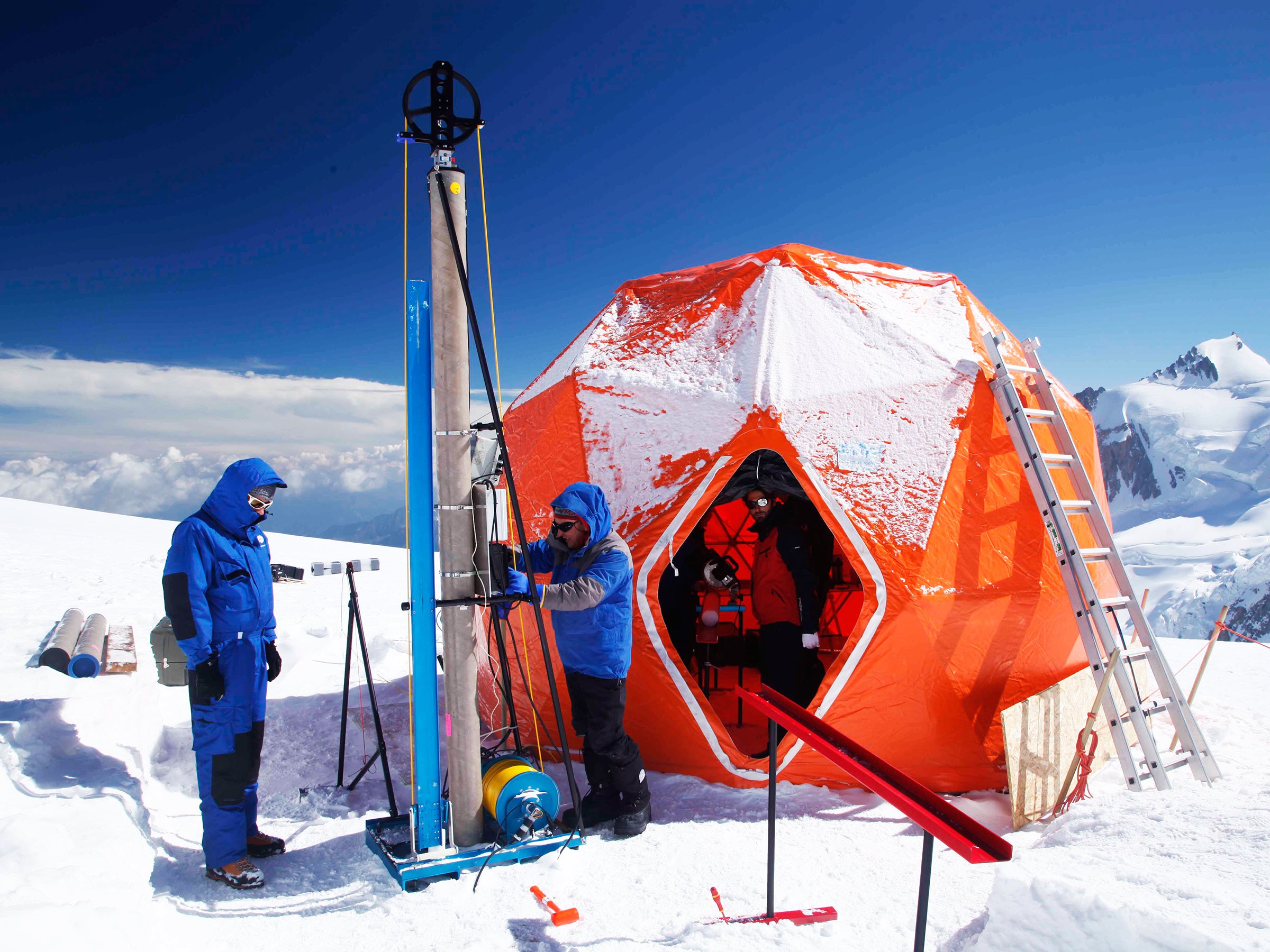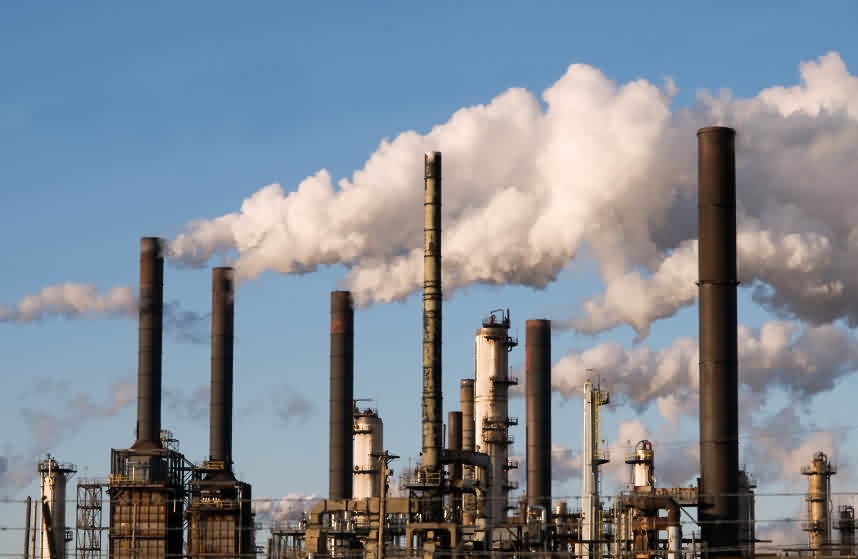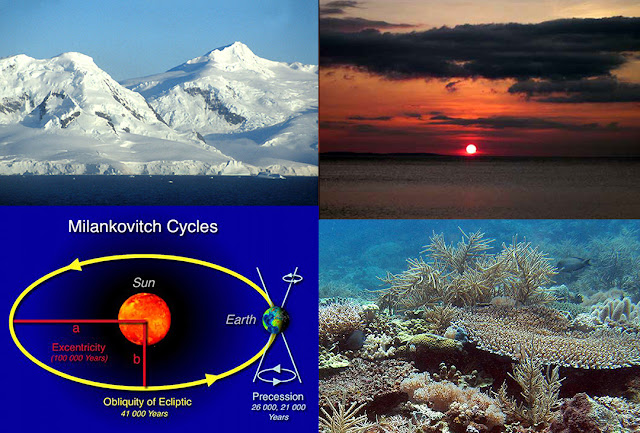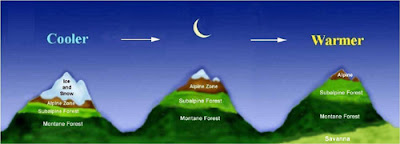G. C. Williams, California Academy of Sciences (Last updated: 1 May 2019)
Take The Climate Change Quiz
(Answers at end of Question #11)
A. About 120 feet lower than today’s level; B. Approximately the same as it is today; C. Nearly 130 meters lower than the present sea level; D. Significantly higher than it is at present; E. Thirty to fifty feet lower than today’s sea level
3. Match the scientist with their contribution to our knowledge of climate change:
A. The ravages of air pollution (1661); B. The effects of human intervention on climate through deforestation are incalculable and could become catastrophic (1803); C. Atmospheric greenhouse effect (1830's); D. Slight changes in atmospheric composition could bring about climatic variations (1860's); E. Carbon dioxide influences Earth’s climate – changes in the concentration of CO2 in Earth’s atmosphere could alter surface temperatures, especially at higher latitudes (1896); F. Air pollution threatens humanity (1903); G. The world’s climate is warming due to the burning of fossil fuels (1938); H. Eccentricity of the Earth’s orbit and changes in its axial tilt and direction are keys to the Ice Ages and Earth’s dramatic climatic variability in the past (1941); I. Continuous measurements displayed in a graph that shows inreased carbon dioxide concentrations in the Earth’s atmosphere since the late 1950s (1958)
Milutin Milankovitch; Guy Callendar; Charles Keeling; Alexander von Humboldt; Alfred Russel Wallace; Jean Baptiste Fourier; John Tyndall; Svante Arrhenius; John Evelyn
4. The period 1910 to the present exhibits a sharp upward-trending spike in global temperatures that:
A. is best explained as being heavily influenced by anthropogenic causes; B. cannot be explained by natural causes alone; C. is consistent with rising levels of carbon dioxide and other greenhouse gases in the atmosphere; D. all of the above
5. Decreases in which of these factors are indicators of global warming:
A. Humidity; B. Glaciers; C. Sea Level; D. Ocean heat content; E. Air temperature (troposphere); F. Snow cover; G. Sea surface temperature; H. Temperature over oceans; I. Sea ice; J. Temperature over land
6. The term upland displacement refers to increases in montane elevation of plant and animal distributions due to a gradual warming of the near surface atmosphere:
A. True; B. False

7. Choose the correct statement:
A. Climatologists are equally divided regarding the validity of global warming; B. 97% of climate scientists agree that climate warming trends during the last century are at least partially due to human activities; C. Most climatologists believe global warming is a hoax; D. Most scientists agree that our contemporary climate change can be attributed to natural causes

8. It is estimated that 1000 gigatons in total carbon dioxide emissions is the truly
dangerous threshold for humanity, and that we have already exceeded 531 gigatons over the past century
A. True; B. False
9. Milutin Milankovitch, as a POW during WWI, theorized that variations in eccentricity, axial tilt, and precession of the Earth's orbit determined climatic patterns on Earth through orbital forcing.
10. Heightened levels of carbon dioxide absorbed by sea water can gradually change the pH of the water in a process known as ocean acidification. Corals that build coral reefs are suspected of being adversely effected by ocean acidification. What percentage of coral species are actually coral reef builders?
A. 100%; B. 15%; C. 50%; D. 2%
11. Many paleoclimatologists agree that the main cause of massive extinctions in the geological past (such as those that occurred at the end of the Permian, Triassic, and Cretaceous Periods) can best be explained by:
A. Asteroid impacts. B. Devastating episodes of global warming and climate change precipitated by large-scale release of greenhouse gases during cataclysmic volcanic events such as massive basaltic outpourings. C. Continiental Drift. D. Cosmic radiation.
- - - - - - - - - - - - - - - - - - - - - - - - - - - - - - - - - - - - - - - - - - - - - - - - - - - - - - - - - - - - - - - - - - -
ANSWERS
1D; 2C; 3A - Evelyn, B - Humboldt, C - Fourier, D - Tyndall, E - Arrhenius, F - Wallace, G - Callendar, H - Milankovitch, I - Keeling; 4D; 5B, F, I; 6A; 7B; 8A; 9A; 10B; 11B
- - - - - - - - - - - - - - - - - - - - - - - - - - - - - - - - - - - - - - - - - - - - - - - - - - - - - - - - - - - - - - - - - - -

A. About 120 feet lower than today’s level; B. Approximately the same as it is today; C. Nearly 130 meters lower than the present sea level; D. Significantly higher than it is at present; E. Thirty to fifty feet lower than today’s sea level
3. Match the scientist with their contribution to our knowledge of climate change:
A. The ravages of air pollution (1661); B. The effects of human intervention on climate through deforestation are incalculable and could become catastrophic (1803); C. Atmospheric greenhouse effect (1830's); D. Slight changes in atmospheric composition could bring about climatic variations (1860's); E. Carbon dioxide influences Earth’s climate – changes in the concentration of CO2 in Earth’s atmosphere could alter surface temperatures, especially at higher latitudes (1896); F. Air pollution threatens humanity (1903); G. The world’s climate is warming due to the burning of fossil fuels (1938); H. Eccentricity of the Earth’s orbit and changes in its axial tilt and direction are keys to the Ice Ages and Earth’s dramatic climatic variability in the past (1941); I. Continuous measurements displayed in a graph that shows inreased carbon dioxide concentrations in the Earth’s atmosphere since the late 1950s (1958)
Milutin Milankovitch; Guy Callendar; Charles Keeling; Alexander von Humboldt; Alfred Russel Wallace; Jean Baptiste Fourier; John Tyndall; Svante Arrhenius; John Evelyn
4. The period 1910 to the present exhibits a sharp upward-trending spike in global temperatures that:
A. is best explained as being heavily influenced by anthropogenic causes; B. cannot be explained by natural causes alone; C. is consistent with rising levels of carbon dioxide and other greenhouse gases in the atmosphere; D. all of the above
5. Decreases in which of these factors are indicators of global warming:
A. Humidity; B. Glaciers; C. Sea Level; D. Ocean heat content; E. Air temperature (troposphere); F. Snow cover; G. Sea surface temperature; H. Temperature over oceans; I. Sea ice; J. Temperature over land
6. The term upland displacement refers to increases in montane elevation of plant and animal distributions due to a gradual warming of the near surface atmosphere:
A. True; B. False

7. Choose the correct statement:
A. Climatologists are equally divided regarding the validity of global warming; B. 97% of climate scientists agree that climate warming trends during the last century are at least partially due to human activities; C. Most climatologists believe global warming is a hoax; D. Most scientists agree that our contemporary climate change can be attributed to natural causes

8. It is estimated that 1000 gigatons in total carbon dioxide emissions is the truly
dangerous threshold for humanity, and that we have already exceeded 531 gigatons over the past century
A. True; B. False
9. Milutin Milankovitch, as a POW during WWI, theorized that variations in eccentricity, axial tilt, and precession of the Earth's orbit determined climatic patterns on Earth through orbital forcing.
10. Heightened levels of carbon dioxide absorbed by sea water can gradually change the pH of the water in a process known as ocean acidification. Corals that build coral reefs are suspected of being adversely effected by ocean acidification. What percentage of coral species are actually coral reef builders?
A. 100%; B. 15%; C. 50%; D. 2%
11. Many paleoclimatologists agree that the main cause of massive extinctions in the geological past (such as those that occurred at the end of the Permian, Triassic, and Cretaceous Periods) can best be explained by:
A. Asteroid impacts. B. Devastating episodes of global warming and climate change precipitated by large-scale release of greenhouse gases during cataclysmic volcanic events such as massive basaltic outpourings. C. Continiental Drift. D. Cosmic radiation.
- - - - - - - - - - - - - - - - - - - - - - - - - - - - - - - - - - - - - - - - - - - - - - - - - - - - - - - - - - - - - - - - - - -
ANSWERS
1D; 2C; 3A - Evelyn, B - Humboldt, C - Fourier, D - Tyndall, E - Arrhenius, F - Wallace, G - Callendar, H - Milankovitch, I - Keeling; 4D; 5B, F, I; 6A; 7B; 8A; 9A; 10B; 11B
- - - - - - - - - - - - - - - - - - - - - - - - - - - - - - - - - - - - - - - - - - - - - - - - - - - - - - - - - - - - - - - - - - -

- - - - - - - - - - - - - - -
Natural vs. anthropogenic causes of climate change
Coral bleaching can be seen in this Philippine hard coral (Pocillopora eydouxi). Coral bleaching takes place when the coral loses the symbiotic algal cells (zooxanthellae) in its tissues, due to excessively warm sea surface temperatures. This loss leaves the coral colorless, exposing the white calcium carbonate skeleton of coral, thus appearing bleached. Zooxanthellae give reef corals their characteristic green, gold, or brown colors.- - - - - - - - - - - - - - - - - |
It is unfortunate that the current often emotional and rancorous debate on climate change and global warming gets reduced to a simplified "either/or" argument -- either natural causes or human-induced. In addition, the argument often includes two significant omissions during public debates: (1) The overwhelming contribution of water vapor as a greenhouse gas as well as the atmospheric effects of ozone depletion, and (2) Climate data for the last 20,000 year -- the period prior to the rise of industrialization (ca. 1800 AD). Both natural and anthropogenic causes have been blamed for global warming, and are no doubt responsible for our present situation in some combination, acting as co-contributors in bringing about our current predicament.
A crucial aspect regarding our understanding of climate change in the distant past – and it’s relevance to what is happening globally at present – unfortunately receives very little attention in the often heated debates that concern the issues of global warming, climate change, and our future on planet Earth. That crucial aspect has to do with natural occurrences that have been repeated in the geological past and which have led to profound changes in the global climate.
Many paleoclimatologists, paleogeologists, and paleontologists have long understood that drastic climate change in the geological past has occurred as a result of two main repeating events: (1) titanic volcanic outpouring episodes associated with mass extinctions, and (2) the Milankovitch Cycles associated with the glacial and interglacial cycles.
What does the historical evidence tell us? The Rhone Glacier in Switzerland has melted back 300 meters between 1600 and 1856 (http://www.bbc.com/news/science-environment-34908482), which was before the heavy industrial period of excessive greenhouse gas emissions . Therefore based on the accumulated evidence, the best explanation for our current climate crisis is that we are in the midst of a gradual, naturally-occurring global warming event that is significantly and rapidly being exasperated by anthropogenic pollution.
-
Titanic volcanic outpourings and mass extinctions: At least three major mass extinction events (the Permian/Triassic, the Triassic/Jurassic, and the K-T or Cretaceous/Tertiary) have been linked to rapid global warming events resulting from the release of toxic gases such as carbon dioxide and methane on a gargantuan scale due to huge basaltic outflow episodes. Other factors such as asteroid impacts may have augmented the results, but the main cuse is attributable to repeating volcanic cataclysms:
-
Glacial/Interglacial cycle and the Milankovitch Cycles: These planetary cycles were proposed in the 1920s by Milutin Milanković, a Serbian mathematician, astronomer, climatologist, and geophysicist. We are in the middle of an interglacial period at present known as the Holocene. The last interglacial – known as the Eemian – was 125,000 years ago. During that time, warming temperatures arose globally but greenhouse gases were not involved. It became so warm in the North Atlantic that the Greenland Ice Sheet melted and along with other glacial melting, sea levels rose. The three cycles of Milankovitch (eccentricity, obliquity, and precession) provide astronomical explanations for the Ice Age and the warming periods between the various ice ages of the past known as interglacials.
-
What is happening now (circa 2015-2016)? Since we are still in an interglacial period at present, and by carefully studying what occurred in the last Interglacial, it stands to reason that the Milankovitch cycles at least partially explain the predicament we are in. The fundamental difference between the last interglacial and now is that pollution of the atmosphere by our species (mainly in the form of carbon dioxide and methane) is speeding up the process of global warming and is seriously exacerbating the problem, thus bringing about often abrupt-appearing incidents of climate change, such as prolonged droughts, excessively strong and violent cyclic storms, ever more destructive fire storms, stronger El Niños and coral bleaching events, etc. Another serious contributing factor that also goes virtually totally ignored is that of unbridled human population growth, in which no matter what actions we take, habitat destruction and industrial pollution will no doubt increase rather than be mitigated. The lesson for us today is that rapid uncontrollable global warming has led to periods of mass extinctions in the geological past – a lesson for us to either take heed or ignore - which one will it be?
-
Forgotten Realities: Two issues that are infrequently treated or discussed in the global warming/climate change argument are two significant contributions to the ever-increasing crisis: (1) the generation ofthe potent greenhouse gas methane by seven billion humans (and rapidly growing) and all of their domestic mammals, and (2) the unceasing contribution of greenhouse gases in the higher atmosphere by jet airliners on a global basis.
|
|
1995 was a pivotal year for observation of bleaching events in reef corals. Before that year, bleaching was occassionally encountered, but after 1995 bleached corals became more commonly seen by divers and large-scale bleaching events became more frequent and devastating in impact. |
The "J" curves of human population growth, atmospheric carbon dioxide, and average global temperature. |












